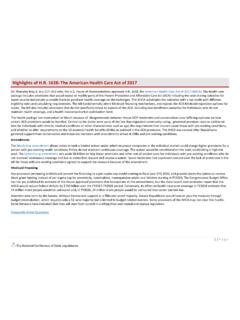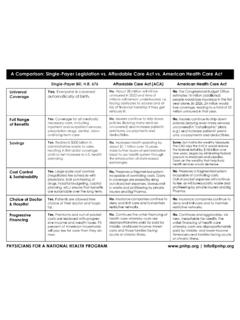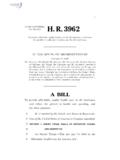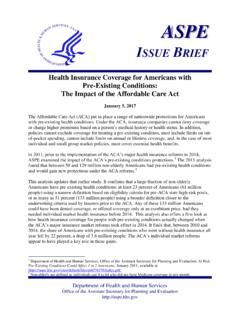Transcription of Estimated Financial Effect of the “American Health Care ...
1 DEPARTMENT OF Health & HUMAN SERVICES Centers for Medicare & Medicaid Services 7500 Security Boulevard, Mail Stop N3-01-21 Baltimore, Maryland 21244-1850 OFFICE OF THE ACTUARY DATE: June 13, 2017 FROM: Paul Spitalnic Chief Actuary SUBJECT: Estimated Financial Effect of the american Health care Act of 2017 The Office of the Actuary has prepared this memorandum in our longstanding capacity as an independent technical advisor to both the Administration and the Congress. The costs, savings, and coverage impacts shown herein represent our best estimates for the american Health care Act. The statements, estimates, and other information provided in this memorandum are those of the Office of the Actuary and do not represent an official position of the Department of Health & Human Services or the Administration.
2 Executive Summary This memorandum summarizes the Office of the Actuary s estimates of the Financial and coverage effects through 2026 of selected provisions of the american Health care Act of 2017 ( 1628), which was passed by the House on May 4, 2017 and which is referred to in this memorandum as the AHCA. Included are the Estimated impacts on net Federal expenditures, Health insurance coverage, Medicaid enrollment and spending by eligibility group, gross and net premiums and out-of-pocket costs in the individual market, total National Health Expenditures, and the Financial status of the Medicare Hospital Insurance (HI) trust fund.
3 Not included in these estimates are the impacts of provisions that would affect other parts of the Federal Budget such as those associated with repealing taxes or fees that do not have a direct Effect on the Medicare or Medicaid program and Federal administrative costs. A summary of the data, assumptions, and methodology underlying our estimates is available in Appendix A. The key findings in this memorandum are as follows: Over fiscal years 2017-2026, selected provisions of the AHCA are anticipated to reduce Federal expenditures by over $328 billion primarily because of lower Medicaid spending. In 2018, the number of uninsured is Estimated to be about 4 million higher under the AHCA than under current law, mainly due to the impact of repealing the individual mandate.
4 By 2026, the number of uninsured is Estimated to be roughly 13 million higher under the AHCA, mostly as a result of declines in eligibility for Medicaid, the impact of the repeal of the individual mandate, and the net reduction to the subsidies available for the purchase of individual insurance. In calendar year 2026, Medicaid enrollment is Estimated to be 8 million lower under the AHCA than under current law due to the combination of two factors: (i) a decline of 6 million in enrollment for newly eligible adults under current law and (ii) a decline of 2 million in enrollment for all other Medicaid enrollees attributable to more frequent 2 eligibility redeterminations, the repeal of retroactive eligibility, and optional State work requirements for adults.
5 When this Effect is combined with the implementation of per capita allotments as specified under the AHCA, overall Medicaid spending is Estimated to be $105 billion, or nearly 11 percent, lower under the AHCA than under current law in 2026. For the individual insurance market, average gross premiums are Estimated to be roughly 13 percent lower in 2026 under the AHCA than under current law. However, average net premiums (that is, premium amounts after Federal and State subsidies are accounted for) are roughly 5 percent higher than under current law, and Estimated average cost-sharing amounts are projected to be roughly 61 percent higher in 2026 under the AHCA than under current law.
6 The impacts vary widely by age and income of the enrollee and depending on whether the enrollee resides in a State that applies for waivers for Essential Health Benefits (EHBs) or community rating. The assets of the HI trust fund are Estimated to be depleted in 2026, 2 years earlier than under current law, and the HI actuarial deficit is Estimated to increase from percent to This result is primarily due to the loss of revenue from the repeal of the additional Medicare tax on high-income earners and additional Medicare disproportionate share hospital (DSH) spending. Over calendar years 2017-2026: o Total national Health spending is Estimated to be $258 billion, or percent, lower under the AHCA than under current law.
7 The national Health spending share of the Gross Domestic Product (GDP) is Estimated to be percent in 2026 under the AHCA percentage point lower than under current law. o Households are Estimated to finance $21 billion, or percent, more of national Health spending, as the expected increase in direct out-of-pocket expenditures of nearly $221 billion under the AHCA is almost entirely offset by lower spending because of declines in employer-sponsored coverage, a reduction in the additional Medicare tax for high-income earners, and the Effect of the elimination of the Health insurance tax on premiums.
8 O The Federal Government is Estimated to finance $253 billion, or percent, less of national Health spending; State and local governments are Estimated to finance $37 billion, or percent, more; and private businesses and other private revenues are expected to finance $63 billion, or percent, less of such spending. The AHCA provides funding from the Patient and State Stability Fund (PSSF) to reduce premiums in the individual market. The estimates presented in this memorandum generally assume that half of the funding would be targeted towards assistance for at-risk populations 1 These estimates were developed based on the 2016 Medicare Trustees Report, known formally as The 2016 Annual Report of the Boards of Trustees of the Federal Hospital Insurance and Federal Supplementary Medical Insurance Trust Funds.
9 3 (lower income, older, and/or poorer Health ) and that the remaining half would be used to lower premiums for all enrollees. Under the AHCA, States can apply for waivers that would allow them to (i) define EHBs and (ii) permit issuers to consider Health status as a rating factor in lieu of the 30-percent surcharge that would otherwise apply for individuals who have not maintained continuous coverage (that is, waive community rating). While it is nearly impossible to predict how States will respond to these options, we have made several key assumptions about State behavior in developing these estimates.
10 These assumptions are not intended to be a prediction of what an individual State will choose to do but are instead intended to produce ultimate outcomes that would be considered reasonable given the degree of uncertainties. The estimates assume that 25 percent of States would choose to waive the requirements of EHBs or community rating. Because of the range of possible outcomes, we also provide the cost and coverage sensitivity for several of those key assumptions. The actual future impacts of the AHCA on Health expenditures, insured status, individual and employer decisions, State behavior, and market dynamics are very uncertain.



















